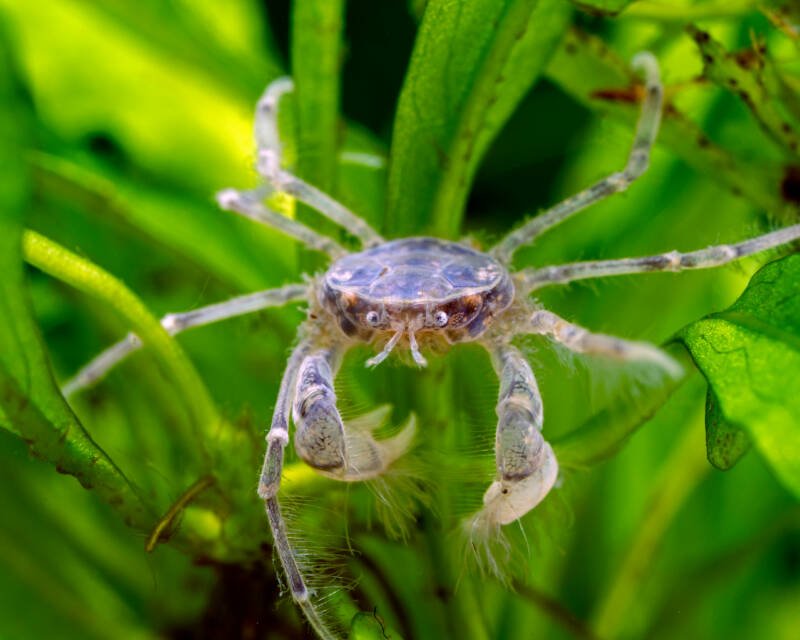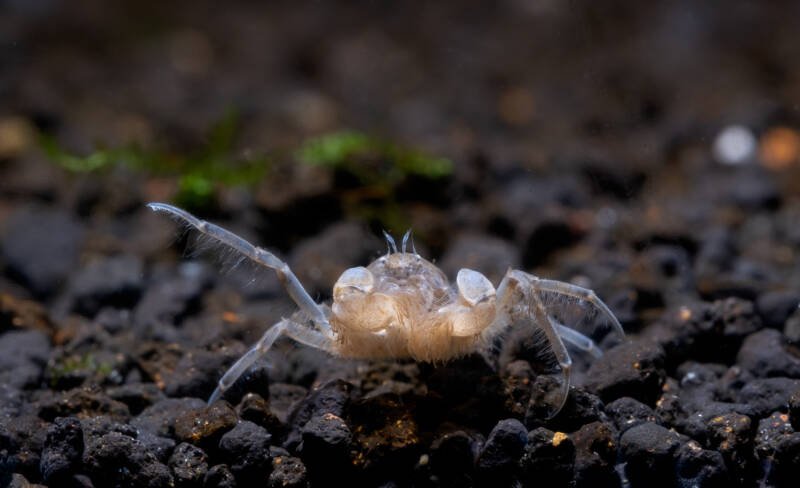Thai micro crabs (Limnopilos naiyanetri) are unique because they are only found in a single location, Thailand.
These rare aquarium crabs have only been found in one river in the entire country, not just anywhere.
Thai micro crabs are fully aquatic, meaning that they spend their entire lives underwater. Wild crabs are often spotted hidden among the roots of floating plants.
Their small size makes them vulnerable to predators, so these shy crustaceans prefer dense plant life to keep them safe.

At a Glance
| Adult size: | 0.5″ (1.3 cm) |
| Minimum tank size: | 5 gal (20 l) |
| Temperature: | 72-82°F (22-28°C) |
| Diet: | omnivore |
| pH: | 6.5-8.0 |
| Behavior: | peaceful |
| Origins: | Thailand |
Color and Appearance
This species of crab is a gray color with brown and white markings.
They have earned themselves the nickname “false spider crabs” because of the long, spider-like legs and claws that are much larger than the main body.

Thai micro crabs, both adults and young, come equipped with small bristles on the legs and claws.
These bristles, called setae, trap small particles of food!
Micro crabs use the same feeding technique as the bamboo shrimp or vampire shrimp.
The word “micro” is a part of their name for a reason, adults grow to a size of just 0.5 inches (1.3 cm)!
Their petiteness makes them perfect for nano aquariums as small as 5 gallons (20 l)!
Behavior and tank mates
Thai micro crabs are very peaceful and do best with other invertebrates such as neocaridina shrimp and various species of snail.
Since these guys are so small, housing them with fish can be very tricky.
Small crabs make a happy snack for a lot of species of fish. Thai micro crabs can be kept singly or in groups.
Good tankmates include:
- Neocaridina shrimp
- Ghost Shrimp
- Ramshorn Snails
- Nerite Snails
- Mystery Snails
- Pygmy Corydoras
- Other small, non-aggressive schooling fish.
Poor tankmates include:
Tank Setup

These crabs, like many crustaceans, are very sensitive to water quality. Therefore, to ensure the crab’s health, always cycle your tank before adding them to it.
A tight-fitting lid with no escape holes is also very important.
Even though these crabs spend the entirety of their life in the water, they love finding ways to escape! So prevent this by securing any and all escape routes.
The housing requirements of this species are very similar to that of dwarf freshwater shrimp.
5 gallons (20 l) is a good starting place to house a small group of crabs.
They prefer waters with a temperature of 72-82°F (22-28°C). A neutral to slightly soft pH is perfect for these little creatures.
A heavily planted tank is a must for this species. Fill your tank to the brim with both rooting and floating plants!
Driftwood and rocks will also be appreciated as this crab loves to remain hidden!
All of this foliage and hardscape will also aid in obscuring bright light. Thai micro crabs prefer a darker environment.
These small crabs can easily be pushed around by strong current, so sponge filters are a prime choice.
Other types of filters such as HOB’s or canister filters will work as well as long as the intake is covered with a fine mesh to prevent young crabs from being sucked in.
If your filter has an adjustable flow, keep it low. If not, you can always lessen the flow with a homemade baffle.
Feeding
Using the small hairs on their body to collect and trap food, Thai micro crabs feed on any plant and animal matter that is scattered throughout the tank.
These crabs do well being fed invertebrate food, algae, and live or frozen foods such as bloodworms and daphnia.
Veggie and algae wafers are also a good addition to their diet.
Pretty much anything that a shrimp would eat can be fed to this species.
Breeding
This species of crabs are egg-layers. The female gestates a clutch of up to 200 eggs inside her abdomen.
The female then releases live larvae. This is where things start to get rough.
Thai micro crabs do not breed well in captivity.
Many breeders have successfully gotten females to release live young, but they never survive for more than a few days.
It is uncertain why these newborn crabs never survive to adulthood.
By all means, if you think you can figure out the right parameters for successful breeding, give it a shot! We’d all love some answers!
Closing Thoughts
Thai micro crabs are a great addition to an aquarium, but they must be treated with the utmost care.
And to be honest, this species isn’t going to set the world on fire in a small tank!
Leave a comment below with any questions you might have!